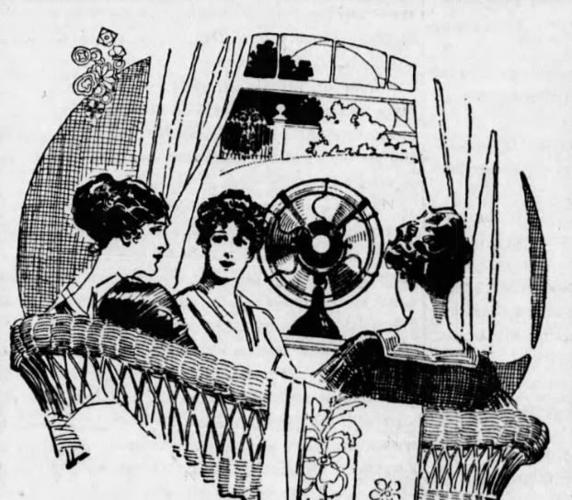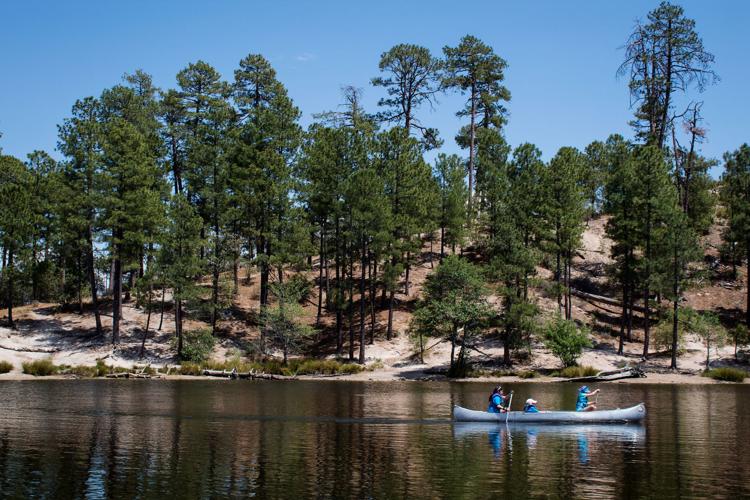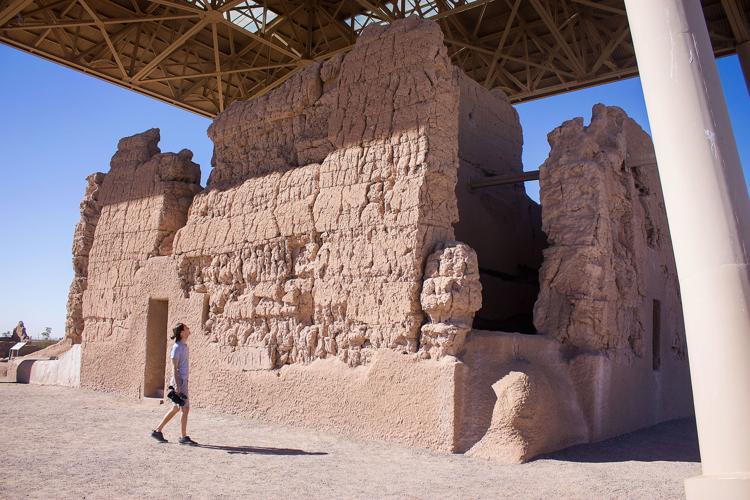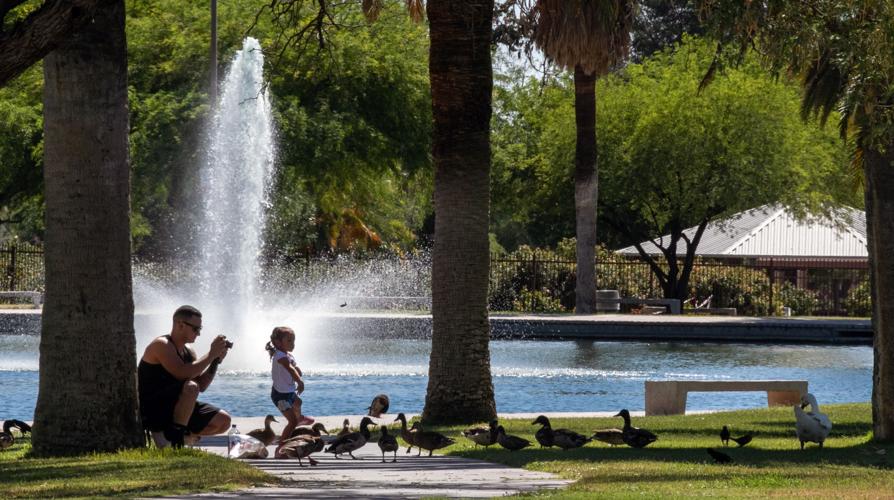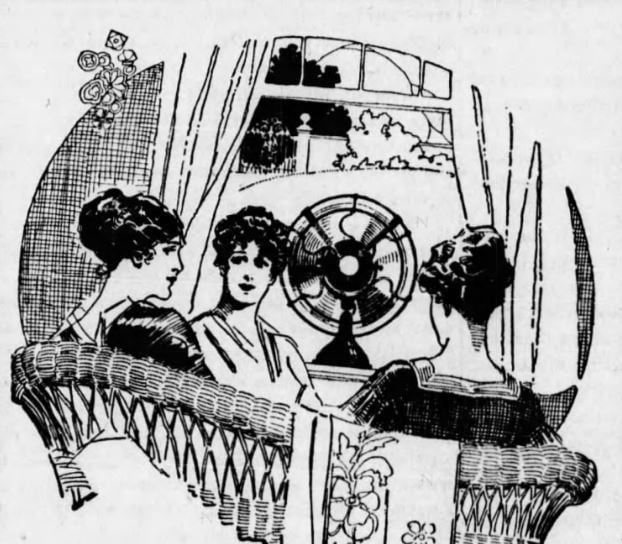For much of Tucson's existence, people have lived here without air conditioning.
Just let that sink in for a minute.
Tucson was founded in 1775. Father Eusebio Kino founded the Mission San Xavier del Bac in the late 1600s, and the Hohokam people lived in the Tucson area near the Santa Cruz River long before that, building canals to irrigate their crops.
But Tucson didn't have reliable electricity for fans until around 1895.
In the late 20s and early 30s, ads for electric refrigerators — a replacement for soggy ice boxes — began appearing frequently in newspapers, and by 1939, many businesses and houses had some kind of evaporative (or swamp) cooler, says Leslie Roe, the director of the Arizona History Museum with the Arizona Historical Society.

An ad for a Frigidaire Electrical Refrigerator in the July 24, 1927 issue of the Arizona Daily Star.
"Prior to the 1920s, everybody would have been using wet sheets and all of those strategies to keep cool," Roe says. "Everyone would have been doing what people had been doing for 10,000 years prior. And then you transition from the 20s to the 40s, and gradually people started adopting electric fans."
Some version of the swamp cooler has been in use by humans in hot places as far back as the Egyptians, according a history on swamp coolers by the Pima County Public Library.
Early Tucson settlers used the sheet-in-door method and hung ollas (clay jars) filled with water in their doorways. And the Santa Cruz River actually had water in it, so people swam.
An October 1931 issue of the Arizona Daily Star featured two stories on its Home and Building Review page about companies attempting to make "home cooling systems" widespread and affordable for residential use.
"If these people who are coming here can be assured of comfort during the summer months, they will not only remain but immigration to this area will be greatly stimulated," Patrick Tidmarsh, one of the men behind that endeavor, told the Star.
He was right.
"The population exploded after evaporative cooling became common," Roe says.
But what about the brave souls who settled in Tucson before that?
We perused old copies of the Arizona Daily Star (and a few copies of the Tucson Citizen and Arizona Republic) and chatted with Roe to learn a bit more about how Tucsonans survived summer in the olden days.
As it turns out, historical heat hacks aren't so different from our own.
When the swamp cooler isn't cutting it and you're finding less excuses to hang out in the Costco freezer section, it's time to think a little outside the ice box.
They got out of town

Rose Canyon Lake is a popular fishing and canoeing destination located 7,000 feet up on Mount Lemmon.
Like today, wealthier Tucsonans just ditched town when summer months arrived. Old copies of the Arizona Daily Star and the Arizona Republic are full of ads enticing sweaty desert rats to come chill in California.

This ad for California resorts appeared in the Arizona Daily Star June 13, 1913. Even then, the lure of the ocean called Tucsonans during summer's heat.
On July 14, 1929, a story in the Star's Sunday paper reported better-than-usual sales for local businesses during the summer months.
"We are getting away from the idea that Tucson is a seasonal town," Monte Mansfield, a Ford dealer, told the Star.
Even before that, an August 27, 1921 editorial page proclaimed "Tucson Now a Twelve Month Business and Tourist City: Closed Summer Myth Is No Longer Tenable."
A mild summer prompted the Star to beseech Tucsonans to stick around next year even when temperatures spike — for the sake of local businesses, people!
Still, it conceded that you might need some cooler air — just find it closer to home. Think Mount Lemmon or "other attractive outing places in which the mountains immediately surrounding Tucson abound."
"People have been going up the mountains for years when it gets hot," Roe says. "We're not the first ones to do that."
Just don't leave for the whole summer.
"It is up to local citizens to begin at once laying plans for a summer of 'business as usual' from May to September, 1922," the Star wrote, already planning for the coming year. "When the influx of fall and winter tourists begins next month, preliminary steps should be taken for inducing them to remain here instead of flitting with the closing days of spring. ... Tucson needs to begin right now an energetic advertising campaign to set before the world the fact that it is not an eight-months, but a live, hustling twelve-months town for both the tourist and the businessman."
The struggle is real.
They avoided the sun

Jackson Ellison, left, and Chris Reits take a break in the shade after loading palm tree trimmings into a chipper under the summer sun on June 12, 2018. The workers were part of a crew working for Corey's Treat Service to trim palm trees at an apartment complex on the west side.
Fellow shade seekers, we see you.
"They used natural shade and geography and sheltered during the hottest part of the day," Roe says of our predecessors. "Native Americans built ramadas. Everyone built some version of that to hide behind."
As we know, crossing the street is worth it if you get to walk in the shade.
"People didn't just stand there in the heat and go, 'It's awful. It's really hot,'" he says. "They said, 'It's cooler here in the shade.'"
Life also adjusted to accommodate the heat. Although we might limit our activity to early mornings and evenings these days, we typically continue about our days, seeking cool air in our cars and then our offices.
"We say, 'How did they do this?' Well, they didn't," Roe says. "They just avoided it as much as possible. They didn't have the freedom of movement we have."
They were smart architects

Barrio Viejo, south of the Tucson Convention Center, is one of the city’s oldest neighborhoods and is packed with historic adobe buildings.
Old adobe homes were designed to keep their inhabitants cool.
A May 31, 1927 story in the Star about builder John W. Murphey boasted that "an adobe home with its fourteen inch walls is cooler in the summer and warmer in the winter than any other type."
Go to the Casa Grande Ruins and check out the "Great House," a preserved adobe house from the Hohokam culture. Desert dwellers have used adobe bricks to keep cool for centuries.

The Casa Grande Ruins are an ancient Hohokam dwelling built out of adobe mud bricks.
Roe also points to window placement in the homes of early settlers.
"They had transom windows, with just a window above the door and high ceilings," he says. "Open that window and then the exterior windows and the air rises up and then flows from room to room and then out of the house to create a natural breeze."
Many homes also had sleeping porches or verandas, where people would retire for the evening, often covered in damp sheets.
"In 1920s Arizona, the second the sun went down, the temperature would just plummet," Roe says. "All you really had to do back in those days was hide from the heat in the day."
They did what they had to do

Rachel Quinton, with this big bright umbrella, a big shade hat and sipping on this large cold soda, trying to stay as cool as she she could, as she was walking down Kolb Road in the heat of the day as the temperature was blazing hot Sunday June 30, 2013.
Roe has a ton of examples of creative people who invented their own version of the swamp cooler or figured out how to power a small fan with alcohol (true story!). What we'll do for a breeze.
"When people are hot they get creative about how to not be hot," Roe says.
Heat hacking genius includes:
• The people who figured out how to make ice in the desert in 1879 before electricity was super reliable.
• An alcohol-powered fan, currently on display at the Arizona Historical Society's museum in Yuma, used burning alcohol to "create a chimney effect and turn a turbine motor" to run the fan in the early years of the 1900s, Roe says.

An ad in the July 28, 1926 issue of the Arizona Daily Star for an electric fan.
• In 1908, someone rigged an apple crate with a wet gunny sack (burlap) and an electric fan. Behold, a makeshift swamp cooler. "People know that when you're wet and the breeze blows, it makes you cool," Roe says. "People have been figuring out how to take advantage of that for thousands of years."
• Soldiers often ditched their cumbersome clothing, burying it in the desert. "We find historically, hot, uncomfortable military accessories buried because soldiers would shed them. ..." Roe says. "We actually have historic records of these things being buried all along trails."
They pretended it wasn't so bad

Despite the heat, Marc Alday and his goddaughter Mila Aguilar, 4, make memories with the ducks at Reid Park Duck Pond on June 26, 2018 in Tucson, AZ.
And it probably wasn't. Roe points out that even in rural Arizona today, nights cool down faster than in the cities, where urban heat causes us to swelter longer. The state itself was a bit cooler when Tucson was first settled, he adds.
Summer expectations for personal hygiene were likely different than ours, too, Roe says.
"They smelled bad, probably ripe to our 21st-century noses," he says.
But that's just the way it was. Summer meant sweat in pre-deodorant world.
In that 1921 editorial we referred to earlier, the Star wrote that "the truth about Tucson's summer climate — long hiding its light under a bushel of misinformation — is that it is ten degrees on an average lower than that of several other Arizona cities of a larger class ... that such heat as it experiences is a dry heat much less oppressive than that of any large eastern city: and finally, that the warm weather of Tucson is both more healthful and more agreeable than the cold sea fogs and winds of Los Angeles or any other California coast city. Tucsonans who go to the coast, or to the east, to escape summer heat, cheat themselves as well as their city.""
The editorial went on to assert that many Tucsonans have come to realize that summer life in the dusty Old Pueblo isn't so bad and is "in fact a much better 'summer resort' than many other places in the southwest and on the Pacific coast which pride themselves on being such."
Take that! You California ads!

This ad for a trip to Los Angeles and San Francisco appeared in the Arizona Daily Star May 21, 1913.
We also found a summer survival gem in the Arizona Daily Star's page Feminine Fashions: Fancies and Foibles for Women on June 9, 1912.
In an essay on "Summer in Tucson," Edith G. Kingsley wrote that anyone who is planning on spending the summer here "shall make your family and friends miserable and uncomfortable complaining about the heat."
So just put on a smile and suck it up.
Here's some of her advice (for women. According to the article, men just see heat as one big joke):
• "Force of habit has everything to do with suffering with the heat. If you are in the habit of making yourself miserable worrying about the warm weather and complaining about it, you are going to feel it a thousand times worse than you would if you kept silent and busy."
• "Keeping the mind occupied, the brain busy, is more cooling than an ice cream soda six times a day."
• "Say you like the warm weather, that it causes you to relax and gives you a needed rest, and you will be surprised how much more comfortable you will feel."
• "Wear clothes that are comfortable: if there is any time in the year when you have a right to be comfortably dressed, it is in the summer time."

An ad in the July 2, 1911 issue of the Arizona Daily Star for suits that will keep you cool.
• "Treat the heat as a good joke, for you cannot get a sunstroke in this altitude, and you can back east. There isn't a particle of danger that you will get sick if you stay here from now until Christmas if you take proper care of yourself." (Alas, we now know that heatstroke is indeed deadly during the summer months.)
• "The thermometer will go on just the same whether you are miserable and make others miserable, or whether you smile. So smile."


